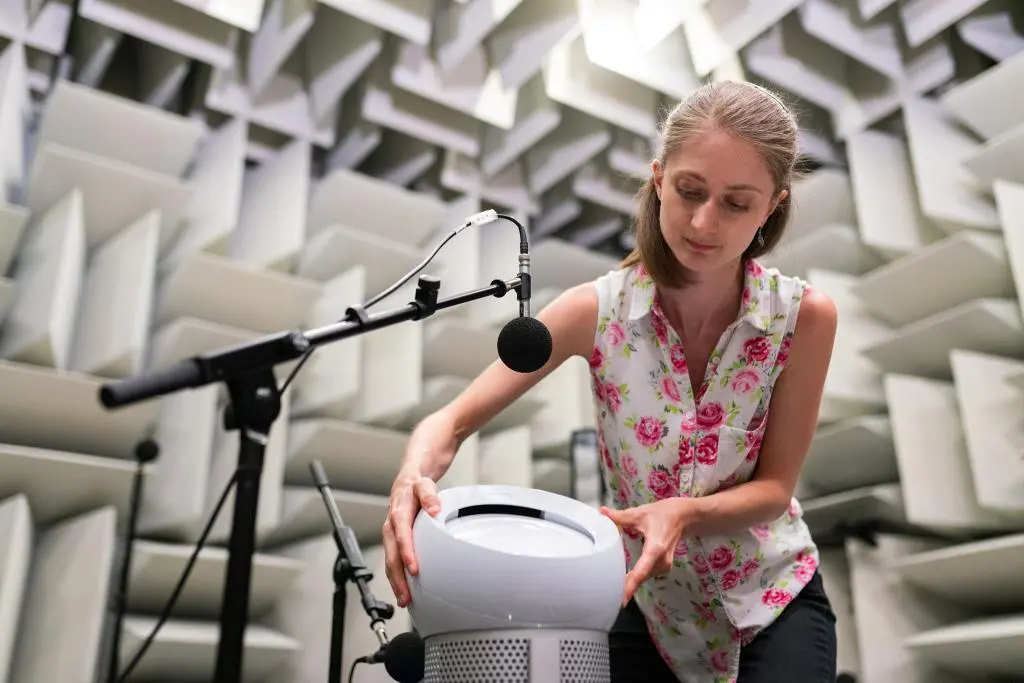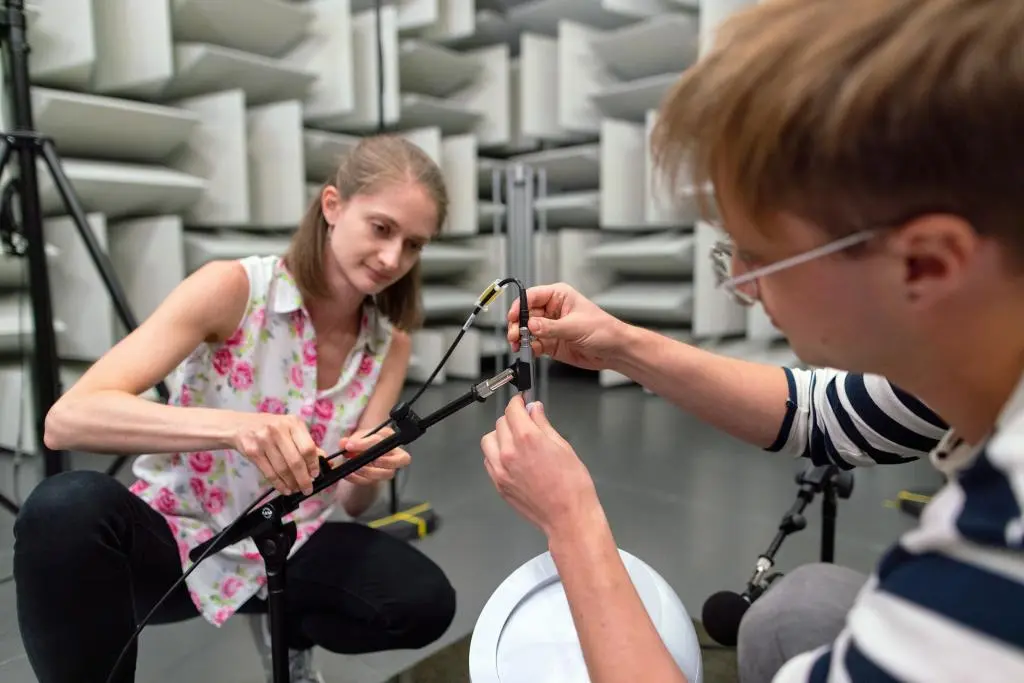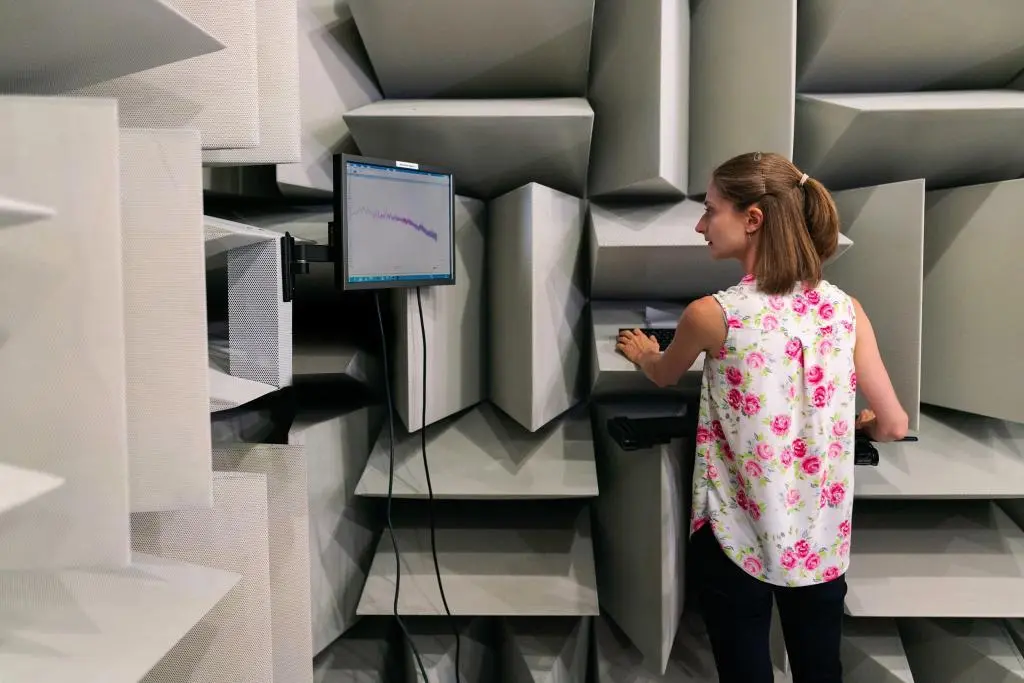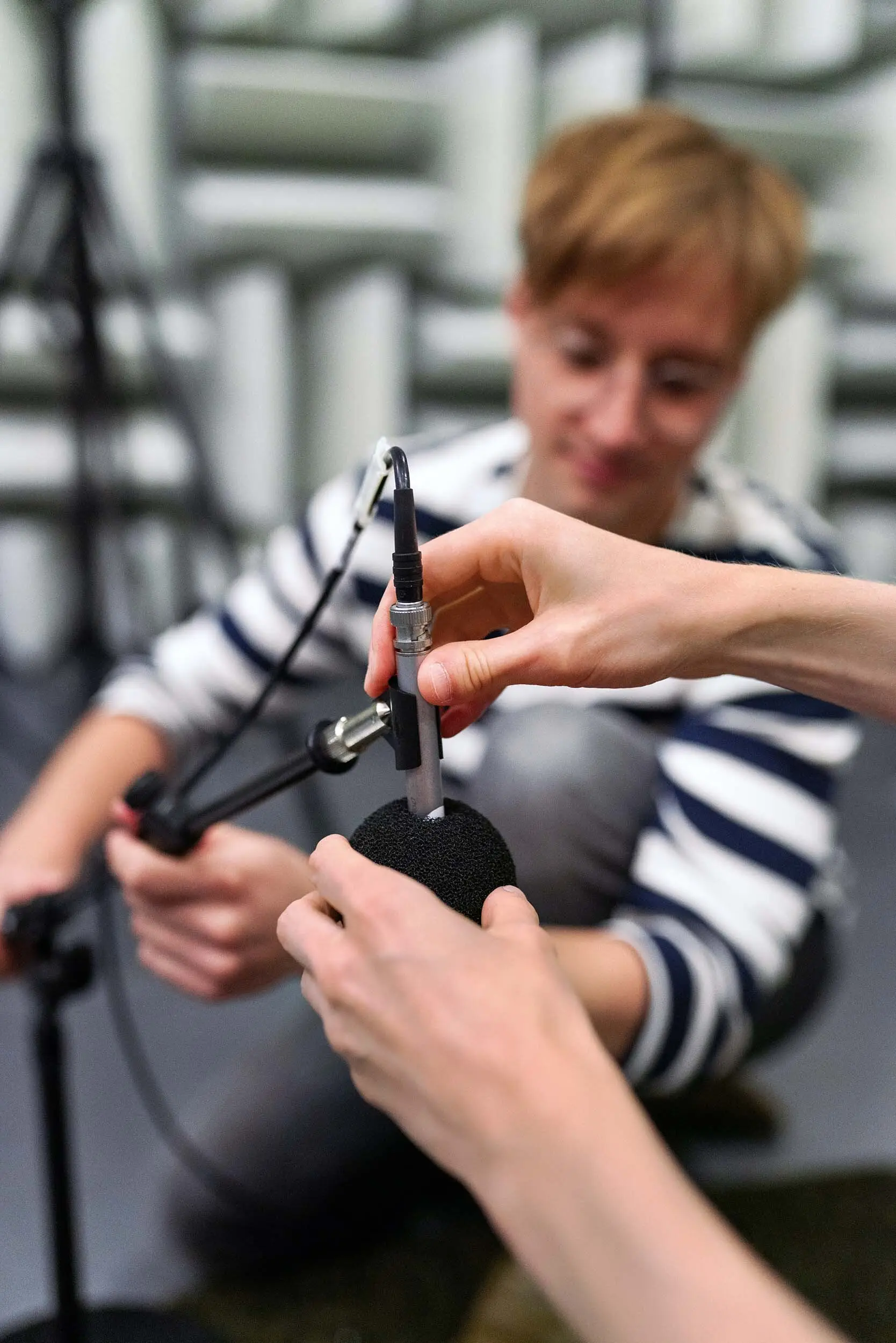The calibration microphone is that mic used for measurement rather than recording purposes.
These types of microphones usually have a flat response because the main idea is to have a accurate and also uncolored picture of audio source.

What is Calibration Microphone: Table of Contents
In the realm of sound and music, precision is paramount. As we embark on this journey to understand the intricacies of the calibration microphone, it’s essential to first grasp the broader context of the audio landscape. This world, teeming with nuances and subtleties, demands not just passion but also an acute attention to detail.
Imagine standing at the edge of a vast sonic terrain, where every sound wave, every frequency, and every note plays a pivotal role in creating a harmonious symphony. This is the audio world, a place where decisions can make or break the final output.
The importance of informed choices in the audio world cannot be overstated. Whether you’re a budding music producer, an established audio engineer, or a curious enthusiast, the tools and equipment you choose will significantly influence the quality of your work. Among these tools, the calibration microphone stands out as a beacon of accuracy, ensuring that what you hear and produce is as close to perfection as possible.
But, like any other tool, there’s a cost associated with quality. Venturing into the world of audio equipment can sometimes feel like navigating a maze, with countless options vying for your attention. This brings us to the cost and benefits of demoing audio products. While the initial investment in high-quality equipment, such as a calibration microphone, might seem steep, the benefits are manifold. Demoing or testing these products before a full commitment allows you to gauge their potential and ensure they align with your needs. After all, in the pursuit of audio excellence, every decibel counts, and every choice matters.
In the subsequent sections, we’ll delve deeper into the world of calibration microphones, unraveling their mysteries and showcasing their indispensable role in the audio landscape. So, strap in and prepare for an enlightening sonic adventure!
Calibration Microphones 101: A Primer
In the vast universe of audio equipment, certain tools stand out for their specialized roles. Among these, the calibration microphone emerges as a cornerstone, ensuring that sound measurements are as accurate as they can be. But what exactly is this device, and why is it so crucial in the world of sound?
The Basics of Calibration
At its core, a calibrated measurement microphone is a precision tool designed to capture sound with an unparalleled level of accuracy. Unlike standard microphones that might color or alter the sound in some way, calibrated microphones are engineered to provide a flat and neutral response across a wide frequency range. This means they don’t favor bass, midrange, or treble frequencies; they capture everything as it is.
Now, you might wonder, why is such precision necessary? The answer lies in the very essence of sound engineering and production. When setting up audio systems, be it in a studio, a concert hall, or even a home theater, it’s imperative to understand how sound behaves in that particular environment. Any misjudgment or error can lead to a skewed audio experience, robbing the listener of the true essence of the sound. This is where the calibration microphone steps in, acting as the ears of the audio engineer, capturing sound data with precision, and ensuring that the audio system’s output is optimized for the environment.
The core purpose and significance of calibration microphones in the audio industry are vast. They are used in a myriad of applications, from tuning concert hall acoustics to ensuring that a home theater system provides an immersive audio experience. They help sound engineers and producers make informed decisions, ensuring that the final audio output, whether it’s a music track, a movie soundtrack, or a live concert, is delivered as the creator intended.

Why Calibration Microphones are Non-Negotiable?
In the intricate dance of sound waves and frequencies, there’s a silent maestro that ensures every note, every beat, and every tone is captured in its purest form. This maestro is none other than the calibration microphone. Its role in the audio world is so pivotal that bypassing it can lead to a cascade of inaccuracies, compromising the very essence of sound.
The Need for Precision
Imagine crafting a masterpiece, pouring hours into perfecting every detail, only to realize that its presentation is flawed. This is analogous to producing sound without the precision of a calibration microphone. The undeniable need for a measurement microphone in speaker calibration arises from the quest for sonic perfection. Speaker calibration is not just about adjusting volume levels; it’s about ensuring that the sound emanating from the speakers is true to its source, free from distortions or biases. Whether it’s the subtle notes of a classical piece or the roaring bass of an electronic track, every sound element needs to be represented accurately. And this is where the calibration microphone shines, capturing sound data with such precision that it becomes the gold standard for any calibration process.
Calibrated vs. Regular Mics
At first glance, one might wonder: aren’t all microphones designed to capture sound? Why the distinction? The answer lies in the very purpose and design of these microphones.
Regular studio microphones are crafted to capture sound for recording purposes. They might emphasize certain frequencies to enhance vocal warmth or instrument clarity. Such coloration, while desirable for recording, is detrimental for measurement purposes.
On the other hand, calibrated measurement microphones are the epitome of neutrality. They don’t favor any frequency over another. Their design ensures a flat response across the entire frequency spectrum. This neutrality is crucial when measuring sound in an environment, as it ensures that the data captured is a true representation of the sound in that space, devoid of any biases.
In essence, the stark differences between calibrated measurement microphones and regular studio microphones boil down to their core purpose. While studio mics aim to capture sound in the most pleasing manner, calibrated mics aim to capture sound in the most accurate manner. And in the world of audio measurements, accuracy is everything.
Decoding the Science Behind Calibrated Measurement Mics
The world of audio is a symphony of intricate details, where every element plays a pivotal role in crafting the perfect sound. At the heart of this orchestra is the calibration microphone, a tool that embodies the fusion of art and science. Let’s delve deeper into the technicalities and marvels of these microphones, unraveling the science that makes them indispensable.
The Essence of Calibration
Calibration is not just a process; it’s a commitment to accuracy. At its core, the essence of calibrated measurement microphones is to ensure that sound is captured in its purest, most unaltered form. Unlike regular microphones that might add their own color or bias to the sound, calibrated mics are designed to be the mirror of the audio world, reflecting sound exactly as it is. This meticulous design ensures that when you’re measuring the acoustics of a room or calibrating a speaker system, you’re working with data that’s as close to the truth as technologically possible.
Omni vs. Uni: The Directional Dilemma
In the realm of microphones, directionality plays a crucial role. Omnidirectional microphones, as the name suggests, capture sound from all directions. This 360-degree sound capture is invaluable in environments where sound sources are scattered or where ambient noise measurement is crucial.
On the other hand, uni-directional microphones focus on capturing sound from a specific direction, often making them ideal for targeted sound capture, like in interviews or stage performances. However, when it comes to sound measurements and calibrations, the broad capture range of omnidirectional mics often makes them the preferred choice, ensuring that no sonic detail is missed.
The Heartbeat of Mics: Frequency Response
Every sound we hear, from the softest whisper to the loudest roar, falls within a frequency range. The ability of a microphone to capture these frequencies accurately is termed its frequency response. For calibrated measurement microphones, this response needs to be as flat as possible, ensuring that no frequency is unduly amplified or suppressed. It’s the heartbeat of measurement microphones, dictating their accuracy and reliability. A mic with a skewed frequency response might paint a distorted picture of the sound environment, leading to flawed measurements and calibrations.
Investing Smart in Calibration Mics
The world of calibrated measurement microphones offers a spectrum of choices, each with its own price tag and performance metrics. While it might be tempting to opt for the most expensive mic, thinking it guarantees the best performance, it’s essential to understand your specific needs. The price range and performance spectrum of measurement microphones vary widely, with some high-end mics offering features that might be overkill for basic setups. Conversely, budget-friendly mics might suffice for amateur setups but fall short in professional environments. The key is to strike a balance, understanding the nuances of the mic’s performance metrics, and aligning them with your requirements.
The Great Debate: Can Studio Mics Double as Measurement Mics?
In the dynamic world of audio, questions often arise about the versatility of equipment. One such debate that has intrigued professionals and enthusiasts alike is whether studio microphones, known for their recording prowess, can double up as measurement mics. Let’s delve into this debate, examining the capabilities of studio mics and understanding the nuances that set them apart from dedicated calibration microphones.
Studio Mics Under the Lens
Studio microphones are the darlings of the recording world. Crafted for capturing vocals, instruments, and ambient sounds, they are engineered to reproduce sound in the most sonically pleasing manner. But when putting common studio microphones to the test for measurement purposes, the results can be a mixed bag.
While studio mics excel in capturing sound with warmth, clarity, and depth, they often introduce subtle colorations to enhance the audio. These colorations, while desirable for recording, can skew measurements, leading to inaccuracies. In contrast, calibration microphones are designed for neutrality, ensuring a flat and unbiased capture across the frequency spectrum.
Omni vs. Cardioid: A Deep Dive
The world of studio microphones offers a plethora of choices, with omnidirectional (omni) and cardioid mics being among the most popular. Omni mics capture sound from all directions, making them ideal for capturing ambient sounds or group recordings. Cardioid mics, on the other hand, have a heart-shaped pickup pattern, focusing on sound coming from the front and minimizing ambient noise.
When taking a deep dive into frequency response differences, omni mics generally offer a more consistent response across frequencies, making them closer in performance to calibration mics. Cardioid mics, while excellent for isolating sound sources, can introduce variations in frequency response, especially at off-axis angles. This can lead to potential inaccuracies when used for measurement purposes.
The Risks of Non-Calibrated Mics
Venturing into the world of audio measurements with non-calibrated mics can be akin to walking a tightrope without a safety net. The risks and repercussions of using non-calibrated mics for room correction are manifold.
Firstly, without the neutrality of a calibration microphone, the measurements can be biased, leading to flawed calibrations. This can result in an audio output that’s far from optimal, with certain frequencies being either too pronounced or too subdued. Secondly, without the precision of a calibration profile tailored for the microphone, there’s no way to correct for these inherent biases. This can lead to a cascading effect, where one flawed measurement leads to another, compromising the entire calibration process.
In conclusion, while studio microphones are unparalleled in their recording capabilities, they fall short when it comes to precise audio measurements. The world of sound is intricate, and when it comes to calibration, there’s no room for compromise. The calibration microphone, with its precision and neutrality, remains the undisputed champion in this arena.

Room Correction: The Silent Game-Changer in Audio Production
In the symphony of sound production, every element plays a pivotal role. From the instruments to the acoustics, each component contributes to the final masterpiece. However, there’s one aspect that often goes unnoticed, silently shaping the soundscape and ensuring sonic perfection: room correction. With the aid of tools like the calibration microphone, room correction has transformed audio production, making it an art of precision and clarity.
The Revealing Survey
Recent surveys among audio professionals have shed light on a critical aspect of sound production: the significance of speaker calibration in studios. The findings were illuminating. A staggering majority of professionals emphasized the role of speaker calibration as a cornerstone of their production process.
Why this emphasis? Because studios, regardless of their size or design, have their unique acoustic characteristics. These can introduce unwanted resonances, reflections, and colorations to the sound. Speaker calibration, aided by tools like the calibration microphone, ensures that the audio output from the speakers is tailored to the room’s acoustics, delivering sound as it’s intended to be heard.
Amplifying Benefits: The Power of Calibrated Measurement Mics in Room Correction
While room correction software plays a significant role in shaping the sound, the real hero behind the scenes is the calibration microphone. Let’s delve into the advantages of calibrated measurement mics in room correction:
- Precision Personified: Calibrated mics capture sound with an unparalleled level of accuracy. This ensures that the room’s acoustical anomalies are mapped with precision, allowing for more effective corrections.
- Consistency Across the Board: With calibrated mics, measurements are not just accurate but also consistent. Whether you’re setting up a new studio or recalibrating an existing one, you can expect consistent results every time.
- Tailored Soundscapes: Every room has its sonic signature. Calibrated mics ensure that this signature is captured in its entirety, allowing for corrections that are tailored to the room’s unique characteristics.
- Elevated Audio Experience: With accurate room measurements, the correction software can work its magic more effectively. The result? A listening experience that’s immersive, clear, and true to the source.

FAQs: Answering the Burning Questions
In the realm of audio engineering, the calibration microphone stands as a beacon of precision and accuracy. As with any specialized tool, it’s natural to have questions about its functionality, benefits, and significance. Let’s dive into some of the most frequently asked questions about calibration microphones and shed light on their pivotal role in the audio industry.
Why is room correction pivotal for audio production?
Room correction is essential because every room introduces its unique set of acoustical characteristics, which can affect the sound quality. These can include reflections, resonances, and other anomalies. By employing room correction, audio professionals can ensure that the sound produced is free from these room-induced biases, resulting in a clearer, more accurate audio output.
How do calibrated measurement mics elevate audio quality in a studio?
Calibrated measurement mics are designed to capture sound with unparalleled accuracy. They come with specific calibration profiles that account for any inherent biases, ensuring that the sound captured is a true representation of the source. This precision allows for more effective room correction, ensuring that the audio output is of the highest quality, free from distortions and colorations.
What are the potential pitfalls of using non-calibrated mics for room correction?
Using non-calibrated mics can introduce inaccuracies in the measurements. These mics might have biases or colorations that can skew the data. As a result, the room correction applied based on these flawed measurements might not be optimal, leading to subpar audio quality and potential issues like frequency imbalances or phase problems.
How do different smoothing levels influence the interpretation of frequency response graphs?
Smoothing levels in frequency response graphs determine how much the minor fluctuations in the data are “smoothed out.” Higher smoothing levels can make the graph look flatter and cleaner, but they might hide some details. On the other hand, lower smoothing levels show more detail but can appear more chaotic. It’s essential to choose the right smoothing level to get an accurate representation of the audio environment.
What are the recommendations for those looking to invest in measurement microphones?
When investing in measurement microphones, it’s crucial to prioritize accuracy and reliability. Look for mics that come with detailed calibration profiles. It’s also beneficial to consider the mic’s frequency response, directional characteristics, and build quality. Reading reviews and seeking recommendations from professionals can also guide the decision-making process.
Why is investing in a calibrated measurement microphone a wise decision?
Investing in a calibrated measurement microphone ensures that you’re equipped with a tool that offers precision and consistency. This not only elevates the audio quality in projects but also reduces the time and effort spent on post-production corrections. In the long run, the benefits in terms of quality, professionalism, and efficiency offer a substantial return on investment.
Investing in a calibrated measurement microphone ensures that you’re equipped with a tool that offers precision and consistency. This not only elevates the audio quality in projects but also reduces the time and effort spent on post-production corrections. In the long run, the benefits in terms of quality, professionalism, and efficiency offer a substantial return on investment.
